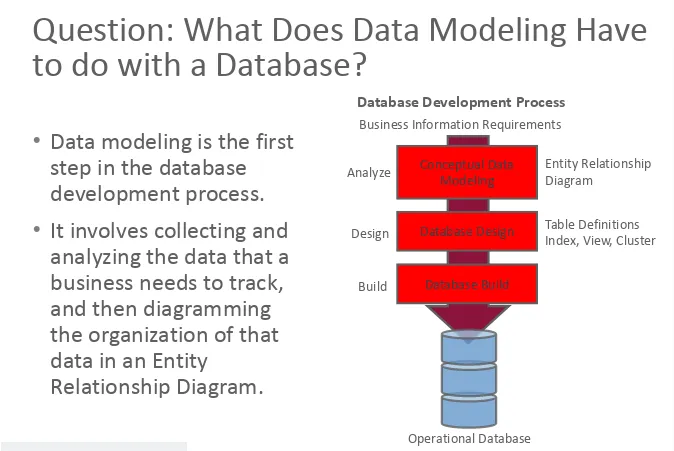Database Design
1-3
Objectives
This lesson covers the following objectives:
• Describe the evolution of the database and give an example
of its role in the business world
• Name important historical contributions in database
development and design
• List and explain the three major steps in the database
DDS1L3
Purpose
• History provides perspective for where we are today in
information technology.
• The next time you use your computer, your video gaming
system, or your smart phone, you will realize how far we’ve come to get to this point and what events brought us here.
• Data Modeling is the first step in database development.
• This lesson includes an overview of the content that is
History of the Database Timeline
• 1960s: Computers become cost effective for private
companies, and storage capacity increases.
• 1970-72: E. F. Codd proposes the relational model for
databases, disconnecting the logical organization from the physical storage.
• 1976: P. Chen proposes the entity relationship model (ERM)
DDS1L3
History of the Database Timeline
• Early 1980s: The first commercially-available relational database systems start to appear at the beginning of the 1980s with Oracle Version 2.
• Mid-1980s: SQL (structured query language) becomes
"intergalactic standard.“
• Early 1990s: An industry shakeout begins with fewer surviving
History of the Database Timeline
• Mid-1990s: Kaboom! The usable Internet/World Wide Web
(WWW) appears. A mad scramble ensues to allow remote access to computer systems with legacy data.
• Late 1990s: The large investment in Internet companies helps
create a tools-market boom for Web/Internet/DB connectors.
• Early 21st century: Solid growth of DB applications continues.
DDS1L3
Question: What Does Data Modeling Have
to do with a Database?
• Data modeling is the first step in the database
development process.
• It involves collecting and analyzing the data that a business needs to track, and then diagramming the organization of that data in an Entity
Relationship Diagram.
Entity Relationship Diagram
Table Definitions Index, View, Cluster
Operational Database Analyze
Design
Build
Business Information Requirements Database Development Process
Database Design
Database Build Conceptual Data
Database Development Process
• Data modeling begins by researching the information
requirements of a business.
• Example: Here is a set of information requirements.
• I manage the Human Resources Department for a large
company. We need to store data about each of our
company’s employees. We need to track each employee's
first name, last name, job or position, hire date and salary. For each employee on commission, we also need to track his/her potential commission.
DDS1L3
Database Development Process
• Each employee is assigned a unique employee number.
• Our company is divided into departments. Each employee is
assigned to a department -- for example, accounting, sales, or development. We need to know the department responsible for each employee and the department location. Each
department has a unique number.
• Some of the employees are managers. We need to know each
Database Development Process
• An entity relationship diagram should
completely capture and accurately model the organization’s
information needs and support the functions of the business.
EXAMPLE
The following entity relationship diagram represents the information requirements of the Human Resources Department.
DEPARTMENT # number
assigned to
responsible for
managed by
DDS1L3
Database Development Process
• Step two, the database design phase of the development
Database Development Process
The table instance chart lists the design specifications of the information and has the following components:
• Table name
• Column names
• Keys: a primary key (PK) is the unique identifier for each row of data; a foreign key (FK) links data in one table to the data in a second table by referring to the PK column in the second
table
DDS1L3
Database Development Process
• Unique: indicates if the value contained in a column is unique
within the table
Database Development Process
• Structured Query
Language (SQL)
commands are used to build the physical
structure of the database.
CREATE TABLE departments
(deptno NUMBER(5) CONSTRAINT depts_deptno_PK PRIMARY KEY, name VARCHAR2(25) CONSTRAINT depts_name_NN NOT NULL, loc VARCHAR2(30) CONSTRAINT depts_loc_NN NOT NULL);
CREATE TABLE employees
(empno NUMBER(9) CONSTRAINT emps_empno_PK PRIMARY KEY, fname VARCHAR2(15) CONSTRAINT emps_fname_NN NOT NULL, lname VARCHAR2(20) CONSTRAINT emps_lname_NN NOT NULL, hiredate DATE CONSTRAINT emps_hiredt_NN NOT NULL,
salary NUMBER(9,2), commission NUMBER(9,2),
mgr NUMBER(9) CONSTRAINT emps_mgr_FK
DDS1L3
Database Development Process
• SQL is also used to populate, access, and manipulate the data within the relational database.
INSERT INTO departments (deptno,name,loc) VALUES
(123,'Accounts','US');
SELECT fname, lname, deptno FROM employees
WHERE deptno = 123;
DATABASE BUILD—Step Three
Terminology
Key terms used in this lesson included:
• Data type
• Foreign key (FK)
• Nulls
• Primary key (PK)
• Table instance chart
DDS1L3
Summary
In this lesson, you should have learned how to:
• Describe the evolution of the database and give an example
of its role in the business world
• Name important historical contributions in database
development and design
• List and explain the three major steps in the database
